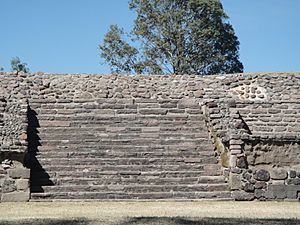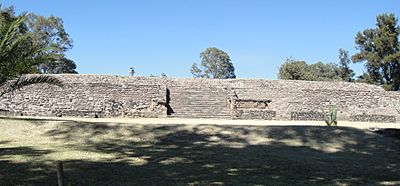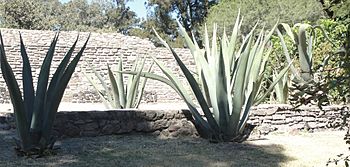El Conde facts for kids
Quick facts for kids Tlatilca Archaeological Site |
||
| Name | El Conde archaeological site | |
| Type | Archaeology | |
| Location | Naucalpan municipality, México State |
|
| Region | Mesoamerica - Valley of Mexico | |
| Coordinates | 19°28′14″N 99°13′07″W / 19.47056°N 99.21861°W | |
| Culture | Tepanec or Tlahuica - Chichimeca | |
| Language | Tlahuica - Chichimec – Nahuatl | |
| Chronology | 1400 a. C. a 1521 d. C. | |
| Apogee | ||
| Period | Postclassical | |
| INAH Web page | El Conde archaeological site | |
El Conde is an ancient archaeological site in Naucalpan, Mexico State. It's found on Ozumba Street, just a few blocks north of Mayo 1 Avenue. This important historical place was officially recognized as a pre-Hispanic monument on December 28, 2001.
Contents
A Look Back in Time
The Valley of Mexico, where Naucalpan is located, has been home to people for over 20,000 years! The story of Naucalpan itself began with a group called the Tlatilco culture.
Early Settlers: The Tlatilco People
The Tlatilco people settled along the "Río Hondo" (Deep River) between 1700 and 600 BCE. This was long before famous civilizations like the Teotihuacan, Toltec, Chichimeca, or Aztec cultures. What archaeologists have found from the Tlatilco culture shows how advanced their society was.
Influences and Changes
During the early Preclassical period (around 1300 to 1400 BCE), a group from the Olmec civilization arrived. They had a big impact on the Tlatilco people. Later, the powerful Teotihuacan civilization also influenced the area.
Between 1000 and 1200 CE, the Chichimeca people took control. They conquered the Tlatilco rulers. It was during this time that the pyramid of El Conde was built. This pyramid stands in what is now the El Conde neighborhood.
New Rulers and Names
After the Chichimeca, the area was ruled by Tlacopan. The Otomi people became the main ethnic group living there. By 1428 CE, the Tepanec people from Azcapotzalco were in charge. However, they were later defeated by the Triple Alliance. This alliance then named the area Naucalpan.
Who Lived Here?
The name Naucalpan comes from the Nahuatl language. Some people think it means "the place of the four quarters." But if you look at the original words, it means "in four houses" or "place of four houses."
The Tlatilco Culture
The Tlatilco civilization was a very important center for people in the early Preclassical period. They arrived in the Naucalpan area between 1700 and 600 BCE. Around 1400 BCE, Otomi groups also had a strong presence. They even called the area Otocampulco, meaning "Place of the Otomi."
The ancient Tlatilco people from "Cerro Tepalcate" were drawn to the growing city of Teotihuacan.
The Chichimec Culture
The Chichimec people arrived between 1000 and 1200 CE. They settled near where the Aztecs would later build the structure we now call El Conde.
The Tepanec Culture
In 1428, the Tepanec people from Azcapotzalco claimed this land. But they lost a war to the Triple Alliance (which included the Aztecs). The land was then given to the Tlacopan kingdom. They later called the place Tacuba.
Exploring the Site
We don't know the original name of this ancient place. It's been called El Conde since the 1800s. That's because a person named Manuel Conde lived on top of the hill back then. So, people started calling it "Cerrito El Conde," meaning "Mr. Conde's Little Hill."
The site was first discovered in 1907 by an archaeologist named Manuel Gamio. He figured out that the site was built during the Postclassical Period.
The Pyramid and Palace
The El Conde pyramid is a large structure, covering over 2,000 square meters. The archaeological site includes a rectangular platform. During ancient times, a tecpan or noble palace was built on top of this platform. It seems this building was from the Aztec Phase III.
This structure is one of the last examples of civil architecture from the late Postclassical period. It has a stairway at the front and some rooms built into it. This type of building was very common back then. Its design is similar to palaces shown in old Aztec books called codices, like the one showing the Netzahualcoyotl Palace.
The tecpan was a super important building in ancient Mesoamerican towns. It served as the government center. This is where leaders met, made political decisions, and handled administrative tasks for the community.




